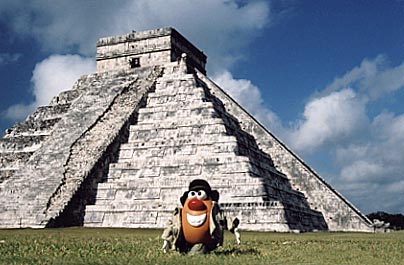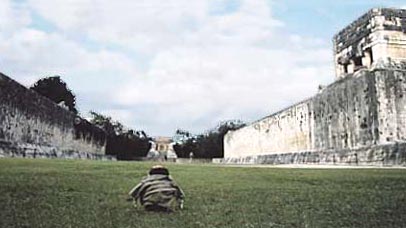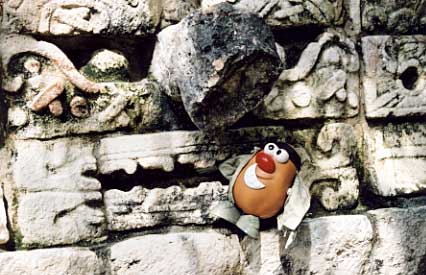
When most people think of Mexico, they think of greasy tacos, bad water, montezuma's revenge and overpriced all-inclusive resorts. Not Spud, for he knows There is much more to this vast North American country, steeped in history and beauty. Most notably, Mexico is home to some of the most amazing ruins of Mesoamerica. Eager to seek a sunnier climate and escape the long bitter Canadian winter, Spud avoided the tourist choked sun havens of Puerto Vallarta and Cancun and decided to do some cultural exploration of the ruins of Mexico's Yucatán peninsula.
 The
ancient Maya originated in the Yucatán around 2600 B.C. and built
many cities throughout Mexico, Belize, Guatemala
and Honduras during their 3500 year existence. Spud decided to visit one
of the best preserved cities to learn more about this mysterious civilization
that all but disappeared in the 11th century. The site he chose was Chichen
Itza; which was built in the late classic period of the Maya around 800-1000
AD.
The
ancient Maya originated in the Yucatán around 2600 B.C. and built
many cities throughout Mexico, Belize, Guatemala
and Honduras during their 3500 year existence. Spud decided to visit one
of the best preserved cities to learn more about this mysterious civilization
that all but disappeared in the 11th century. The site he chose was Chichen
Itza; which was built in the late classic period of the Maya around 800-1000
AD.
The Maya were an amazing civilization; having developed astronomy, calendrical systems and hieroglyphic writing. The Maya were noted as well for elaborate and highly decorated ceremonial architecture, including temple-pyramids, palaces and observatories, all built without metal tools. Chichen Itza was a treasure trove of the Maya architectural mastery. Spud's first stop was to see the city's crown jewel: The 24 metre (80 foot) tall, Temple of Kukulcan (also known as El Castillo).
This enormous step pyramid is an astronomical timepiece hewn without the aid of metal tools. Each face of the four-sided structure has a stairway with ninety-one steps, which, together with the shared step of the platform at the top, add up to 365, the number of days in a year. On each face of the pyramid the central stairway divides the nine terraces into eighteen segments representing the eighteen months of the Mayan calendar. The pyramid is also directionally oriented to mark the solstices and equinoxes. The axes that run through the northwest and southwest corners of the pyramid are oriented toward the rising point of the sun at the summer solstice and its setting point at the winter solstice.
The Maya spent hundreds of years on the structure trying to perfect its accuracy so they could keep track of the changing days and seasons. Spud accomplished the same thing by picking up a calendar at the gift shop for 50 pesos.
 Another
amazing structure near the pyramid is the Great Ball Court, a huge field
measuring 168 metres (550 feet) long and 70 metres (230 feet) wide and
anchored by immense stone temples on each end. Midway down the field and
mounted on the sloping walls lay two stone rings. Teams would face off
against one another and attempt to hit a solid rubber ball through the
ring using only their elbows, hips or knees. The captain of the winning
team would receive the 'honour' of getting a first class ticket to the
Maya heaven by way of a beheading from the losing team. As appealing as
that sounded, the sport failed to attract many players, and since Monster
Trucks hadn't been invented, the grand stadium fell into ruin.
Another
amazing structure near the pyramid is the Great Ball Court, a huge field
measuring 168 metres (550 feet) long and 70 metres (230 feet) wide and
anchored by immense stone temples on each end. Midway down the field and
mounted on the sloping walls lay two stone rings. Teams would face off
against one another and attempt to hit a solid rubber ball through the
ring using only their elbows, hips or knees. The captain of the winning
team would receive the 'honour' of getting a first class ticket to the
Maya heaven by way of a beheading from the losing team. As appealing as
that sounded, the sport failed to attract many players, and since Monster
Trucks hadn't been invented, the grand stadium fell into ruin.
Aside from its design for sport, the Great Ball Court at Chichen Itza also boasts a peculiar acoustic phenomenon. If a person stands at one end of the court, faces the temple wall and speaks, the sound reverberates along the walls and makes its way down to the opposite end of the court and can be heard as plain as day. Eager to test the architectural expertise of the Maya, Spud positioned himself at the southern end of the Ball Court. The acoustic theory passed the test when the tater could tell that the pasty white tourist 168 metres away had enjoyed beans for lunch.
 As
Spud wandered around the immense complex of Chichen Itza, he noticed hundreds
of stone carvings depicting the Maya Rain God, Chaac. Agriculture was
essential to the survival of the Maya so Chaac played an important part
in Mayan ceremonies and rituals. Large masks of the rather big-nosed deity
decorate the facade of almost every structure in the city.
As
Spud wandered around the immense complex of Chichen Itza, he noticed hundreds
of stone carvings depicting the Maya Rain God, Chaac. Agriculture was
essential to the survival of the Maya so Chaac played an important part
in Mayan ceremonies and rituals. Large masks of the rather big-nosed deity
decorate the facade of almost every structure in the city.
The potato approached one of the masks to see if he could gain insight and knowledge as the Maya people had done for centuries. As Spud advanced, the all-knowing stone spirit spoke out to the tater about a luxury condominium he had for sale along the Mayan Riviera near Cozumel. The tutelary continued to tell of the property's ocean view, Olympic-sized pool and weekly maid service.
Spud gracefully declined any interest in buying a time share, but the relentless Chaac pursued; offering a variety of payment plans he claimed 'would suit any budget'. Either way you looked at it, buying in would cost the tater an arm and a leg and he only brought one pair with him on the trip.
Undaunted, the omnipotent Chaac would not let Spud go unless he got a deposit and snapped his toothy limestone jaws onto the poor potato's arm. The crushing chomp forced the 'tato to yelp in pain! Squirming vigorously, Spud was unable to break free. In a last ditch effort, the tater pulled some diced onions out of his rear compartment and shoved them up deep into Chaac's nostrils. The stone deity began to lurch and rumble then let out a tremendous sneeze, sending Spud flying across the compound.
As Spud made a hasty bid for the exit, he no longer wondered what drove the Maya mysteriously out of this grand city so many years ago...
